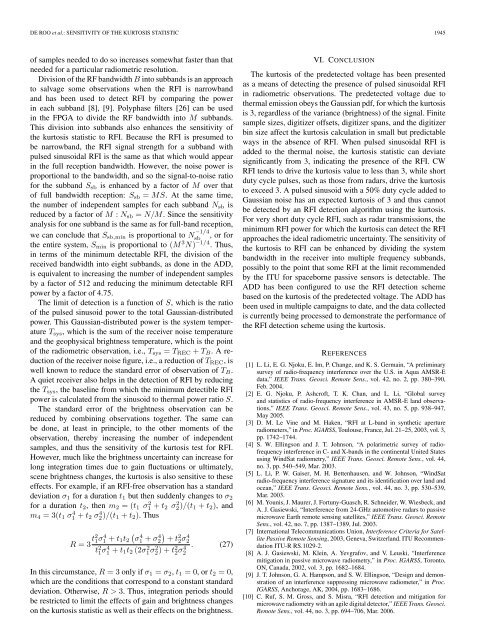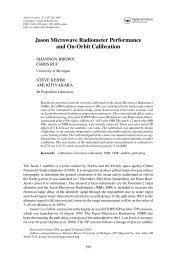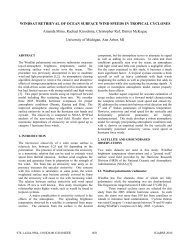Sensitivity of the Kurtosis Statistic as a Detector - Remote Sensing ...
Sensitivity of the Kurtosis Statistic as a Detector - Remote Sensing ...
Sensitivity of the Kurtosis Statistic as a Detector - Remote Sensing ...
You also want an ePaper? Increase the reach of your titles
YUMPU automatically turns print PDFs into web optimized ePapers that Google loves.
DE ROO et al.: SENSITIVITY OF THE KURTOSIS STATISTIC 1945<br />
<strong>of</strong> samples needed to do so incre<strong>as</strong>es somewhat f<strong>as</strong>ter than that<br />
needed for a particular radiometric resolution.<br />
Division <strong>of</strong> <strong>the</strong> RF bandwidth B into subbands is an approach<br />
to salvage some observations when <strong>the</strong> RFI is narrowband<br />
and h<strong>as</strong> been used to detect RFI by comparing <strong>the</strong> power<br />
in each subband [8], [9]. Polyph<strong>as</strong>e filters [26] can be used<br />
in <strong>the</strong> FPGA to divide <strong>the</strong> RF bandwidth into M subbands.<br />
This division into subbands also enhances <strong>the</strong> sensitivity <strong>of</strong><br />
<strong>the</strong> kurtosis statistic to RFI. Because <strong>the</strong> RFI is presumed to<br />
be narrowband, <strong>the</strong> RFI signal strength for a subband with<br />
pulsed sinusoidal RFI is <strong>the</strong> same <strong>as</strong> that which would appear<br />
in <strong>the</strong> full reception bandwidth. However, <strong>the</strong> noise power is<br />
proportional to <strong>the</strong> bandwidth, and so <strong>the</strong> signal-to-noise ratio<br />
for <strong>the</strong> subband S sb is enhanced by a factor <strong>of</strong> M over that<br />
<strong>of</strong> full bandwidth reception: S sb = MS. At <strong>the</strong> same time,<br />
<strong>the</strong> number <strong>of</strong> independent samples for each subband N sb is<br />
reduced by a factor <strong>of</strong> M : N sb = N/M. Since <strong>the</strong> sensitivity<br />
analysis for one subband is <strong>the</strong> same <strong>as</strong> for full-band reception,<br />
we can conclude that S sb,min is proportional to N −1/4<br />
sb<br />
,orfor<br />
<strong>the</strong> entire system, S min is proportional to (M 3 N) −1/4 . Thus,<br />
in terms <strong>of</strong> <strong>the</strong> minimum detectable RFI, <strong>the</strong> division <strong>of</strong> <strong>the</strong><br />
received bandwidth into eight subbands, <strong>as</strong> done in <strong>the</strong> ADD,<br />
is equivalent to incre<strong>as</strong>ing <strong>the</strong> number <strong>of</strong> independent samples<br />
by a factor <strong>of</strong> 512 and reducing <strong>the</strong> minimum detectable RFI<br />
power by a factor <strong>of</strong> 4.75.<br />
The limit <strong>of</strong> detection is a function <strong>of</strong> S, which is <strong>the</strong> ratio<br />
<strong>of</strong> <strong>the</strong> pulsed sinusoid power to <strong>the</strong> total Gaussian-distributed<br />
power. This Gaussian-distributed power is <strong>the</strong> system temperature<br />
T sys , which is <strong>the</strong> sum <strong>of</strong> <strong>the</strong> receiver noise temperature<br />
and <strong>the</strong> geophysical brightness temperature, which is <strong>the</strong> point<br />
<strong>of</strong> <strong>the</strong> radiometric observation, i.e., T sys = T REC + T B .Areduction<br />
<strong>of</strong> <strong>the</strong> receiver noise figure, i.e., a reduction <strong>of</strong> T REC ,is<br />
well known to reduce <strong>the</strong> standard error <strong>of</strong> observation <strong>of</strong> T B .<br />
A quiet receiver also helps in <strong>the</strong> detection <strong>of</strong> RFI by reducing<br />
<strong>the</strong> T sys , <strong>the</strong> b<strong>as</strong>eline from which <strong>the</strong> minimum detectible RFI<br />
power is calculated from <strong>the</strong> sinusoid to <strong>the</strong>rmal power ratio S.<br />
The standard error <strong>of</strong> <strong>the</strong> brightness observation can be<br />
reduced by combining observations toge<strong>the</strong>r. The same can<br />
be done, at le<strong>as</strong>t in principle, to <strong>the</strong> o<strong>the</strong>r moments <strong>of</strong> <strong>the</strong><br />
observation, <strong>the</strong>reby incre<strong>as</strong>ing <strong>the</strong> number <strong>of</strong> independent<br />
samples, and thus <strong>the</strong> sensitivity <strong>of</strong> <strong>the</strong> kurtosis test for RFI.<br />
However, much like <strong>the</strong> brightness uncertainty can incre<strong>as</strong>e for<br />
long integration times due to gain fluctuations or ultimately,<br />
scene brightness changes, <strong>the</strong> kurtosis is also sensitive to <strong>the</strong>se<br />
effects. For example, if an RFI-free observation h<strong>as</strong> a standard<br />
deviation σ 1 for a duration t 1 but <strong>the</strong>n suddenly changes to σ 2<br />
for a duration t 2 , <strong>the</strong>n m 2 =(t 1 σ1 2 + t 2 σ2)/(t 2 1 + t 2 ), and<br />
m 4 =3(t 1 σ1 4 + t 2 σ2)/(t 4 1 + t 2 ). Thus<br />
( )<br />
R =3 t2 1σ1 4 + t 1 t 2 σ<br />
4<br />
1 + σ2<br />
4 + t<br />
2<br />
2 σ2<br />
4<br />
t 2 1 σ4 1 + t 1t 2 (2σ1 2 . (27)<br />
σ2 2 )+t2 2 σ4 2<br />
In this circumstance, R =3only if σ 1 = σ 2 , t 1 =0,ort 2 =0,<br />
which are <strong>the</strong> conditions that correspond to a constant standard<br />
deviation. O<strong>the</strong>rwise, R>3. Thus, integration periods should<br />
be restricted to limit <strong>the</strong> effects <strong>of</strong> gain and brightness changes<br />
on <strong>the</strong> kurtosis statistic <strong>as</strong> well <strong>as</strong> <strong>the</strong>ir effects on <strong>the</strong> brightness.<br />
VI. CONCLUSION<br />
The kurtosis <strong>of</strong> <strong>the</strong> predetected voltage h<strong>as</strong> been presented<br />
<strong>as</strong> a means <strong>of</strong> detecting <strong>the</strong> presence <strong>of</strong> pulsed sinusoidal RFI<br />
in radiometric observations. The predetected voltage due to<br />
<strong>the</strong>rmal emission obeys <strong>the</strong> Gaussian pdf, for which <strong>the</strong> kurtosis<br />
is 3, regardless <strong>of</strong> <strong>the</strong> variance (brightness) <strong>of</strong> <strong>the</strong> signal. Finite<br />
sample sizes, digitizer <strong>of</strong>fsets, digitizer spans, and <strong>the</strong> digitizer<br />
bin size affect <strong>the</strong> kurtosis calculation in small but predictable<br />
ways in <strong>the</strong> absence <strong>of</strong> RFI. When pulsed sinusoidal RFI is<br />
added to <strong>the</strong> <strong>the</strong>rmal noise, <strong>the</strong> kurtosis statistic can deviate<br />
significantly from 3, indicating <strong>the</strong> presence <strong>of</strong> <strong>the</strong> RFI. CW<br />
RFI tends to drive <strong>the</strong> kurtosis value to less than 3, while short<br />
duty cycle pulses, such <strong>as</strong> those from radars, drive <strong>the</strong> kurtosis<br />
to exceed 3. A pulsed sinusoid with a 50% duty cycle added to<br />
Gaussian noise h<strong>as</strong> an expected kurtosis <strong>of</strong> 3 and thus cannot<br />
be detected by an RFI detection algorithm using <strong>the</strong> kurtosis.<br />
For very short duty cycle RFI, such <strong>as</strong> radar transmissions, <strong>the</strong><br />
minimum RFI power for which <strong>the</strong> kurtosis can detect <strong>the</strong> RFI<br />
approaches <strong>the</strong> ideal radiometric uncertainty. The sensitivity <strong>of</strong><br />
<strong>the</strong> kurtosis to RFI can be enhanced by dividing <strong>the</strong> system<br />
bandwidth in <strong>the</strong> receiver into multiple frequency subbands,<br />
possibly to <strong>the</strong> point that some RFI at <strong>the</strong> limit recommended<br />
by <strong>the</strong> ITU for spaceborne p<strong>as</strong>sive sensors is detectable. The<br />
ADD h<strong>as</strong> been configured to use <strong>the</strong> RFI detection scheme<br />
b<strong>as</strong>ed on <strong>the</strong> kurtosis <strong>of</strong> <strong>the</strong> predetected voltage. The ADD h<strong>as</strong><br />
been used in multiple campaigns to date, and <strong>the</strong> data collected<br />
is currently being processed to demonstrate <strong>the</strong> performance <strong>of</strong><br />
<strong>the</strong> RFI detection scheme using <strong>the</strong> kurtosis.<br />
REFERENCES<br />
[1] L. Li, E. G. Njoku, E. Im, P. Change, and K. S. Germain, “A preliminary<br />
survey <strong>of</strong> radio-frequency interference over <strong>the</strong> U.S. in Aqua AMSR-E<br />
data,” IEEE Trans. Geosci. <strong>Remote</strong> Sens., vol. 42, no. 2, pp. 380–390,<br />
Feb. 2004.<br />
[2] E. G. Njoku, P. Ashcr<strong>of</strong>t, T. K. Chan, and L. Li, “Global survey<br />
and statistics <strong>of</strong> radio-frequency interference in AMSR-E land observations,”<br />
IEEE Trans. Geosci. <strong>Remote</strong> Sens., vol. 43, no. 5, pp. 938–947,<br />
May 2005.<br />
[3] D. M. Le Vine and M. Haken, “RFI at L-band in syn<strong>the</strong>tic aperture<br />
radiometers,” in Proc. IGARSS, Toulouse, France, Jul. 21–25, 2003, vol. 3,<br />
pp. 1742–1744.<br />
[4] S. W. Ellingson and J. T. Johnson, “A polarimetric survey <strong>of</strong> radi<strong>of</strong>requency<br />
interference in C- and X-bands in <strong>the</strong> continental United States<br />
using WindSat radiometry,” IEEE Trans. Geosci. <strong>Remote</strong> Sens., vol. 44,<br />
no. 3, pp. 540–549, Mar. 2003.<br />
[5] L. Li, P. W. Gaiser, M. H. Bettenhausen, and W. Johnson, “WindSat<br />
radio-frequency interference signature and its identification over land and<br />
ocean,” IEEE Trans. Geosci. <strong>Remote</strong> Sens., vol. 44, no. 3, pp. 530–539,<br />
Mar. 2003.<br />
[6] M. Younis, J. Maurer, J. Fortuny-Gu<strong>as</strong>ch, R. Schneider, W. Wiesbeck, and<br />
A. J. G<strong>as</strong>iewski, “Interference from 24-GHz automotive radars to p<strong>as</strong>sive<br />
microwave Earth remote sensing satellites,” IEEE Trans. Geosci. <strong>Remote</strong><br />
Sens., vol. 42, no. 7, pp. 1387–1389, Jul. 2003.<br />
[7] International Telecommunications Union, Interference Criteria for Satellite<br />
P<strong>as</strong>sive <strong>Remote</strong> <strong>Sensing</strong>, 2003, Geneva, Switzerland. ITU Recommendation<br />
ITU-R RS.1029-2.<br />
[8] A. J. G<strong>as</strong>iewski, M. Klein, A. Yevgrafov, and V. Leuski, “Interference<br />
mitigation in p<strong>as</strong>sive microwave radiometry,” in Proc. IGARSS, Toronto,<br />
ON, Canada, 2002, vol. 3, pp. 1682–1684.<br />
[9] J. T. Johnson, G. A. Hampson, and S. W. Ellingson, “Design and demonstration<br />
<strong>of</strong> an interference suppressing microwave radiometer,” in Proc.<br />
IGARSS, Anchorage, AK, 2004, pp. 1683–1686.<br />
[10] C. Ruf, S. M. Gross, and S. Misra, “RFI detection and mitigation for<br />
microwave radiometry with an agile digital detector,” IEEE Trans. Geosci.<br />
<strong>Remote</strong> Sens., vol. 44, no. 3, pp. 694–706, Mar. 2006.





